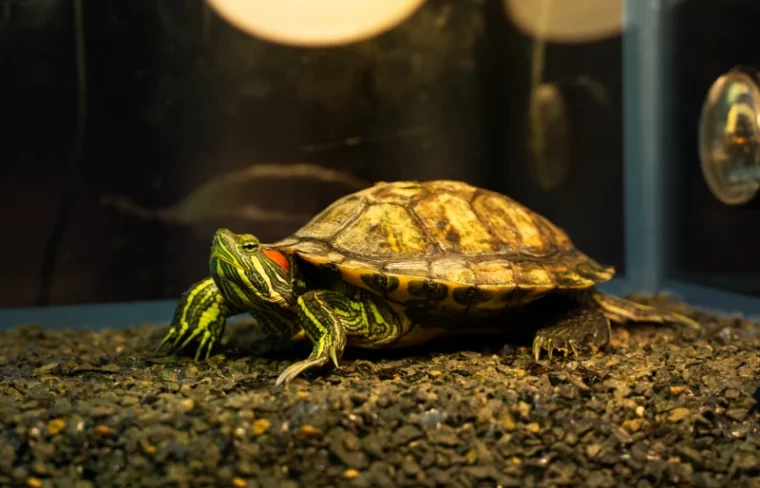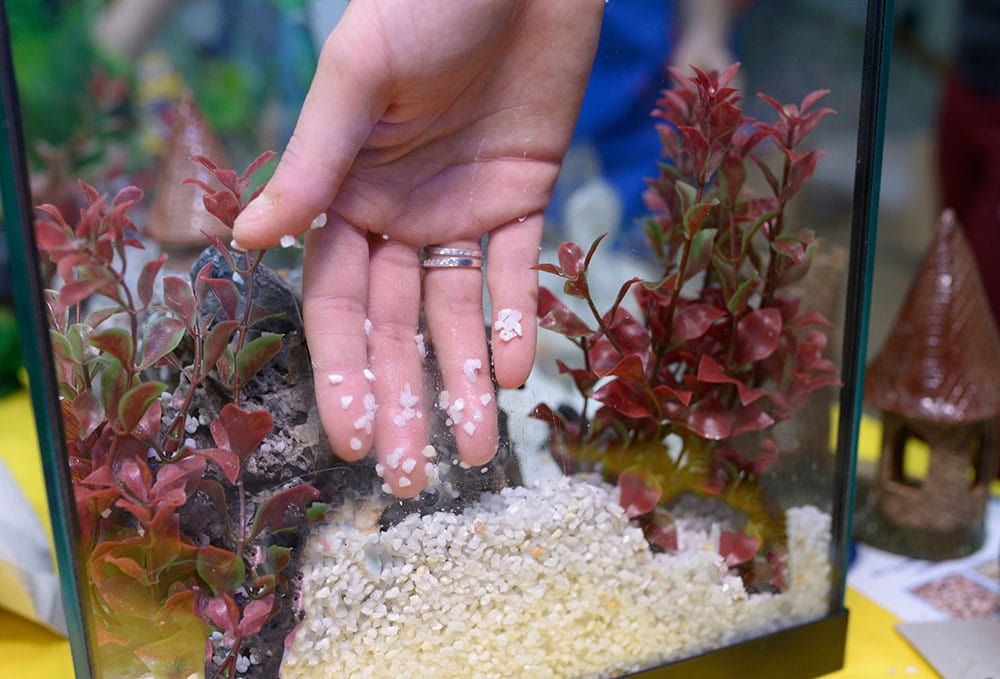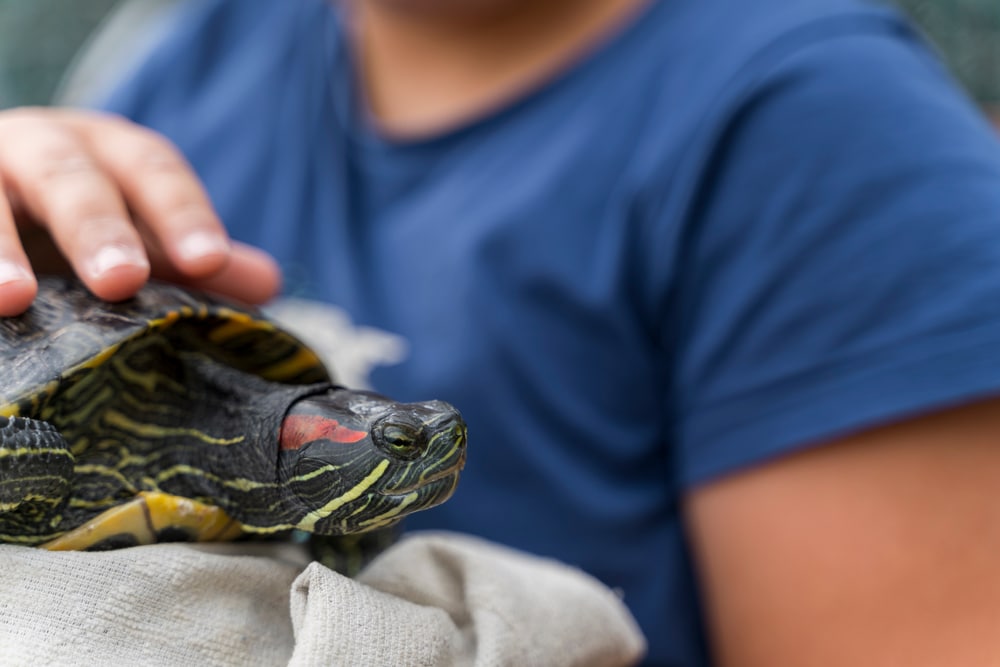
Click to Skip Ahead
Turtles are intriguing little pets that are fun to watch. But they’re also messy little reptiles that seemingly love nothing more than messing up their water and creating a mess for you to clean up. Until there is such a thing as a self-cleaning tank that actually works, it is going to be your responsibility as a turtle owner to keep the tank clean and the water clear.
Daily cleaning takes a few minutes, and it can greatly reduce the need for frequent deep cleaning, but it never completely replaces this need. You will have to remove everything from the tank at some point, and then clean the whole thing out before cleaning and replacing all the equipment.
Take heart from the fact that a clean tank makes it easier to watch your turtle zooming around inside so it will bring you joy. Right until you notice it getting dirty again!
How to Clean Your Turtle’s Tank
Once a month, you should perform a full, deep clean. This can be an arduous task, but it is one of the necessary tasks that you have to undertake when you keep turtles.
Before You Start: Gather the Supplies
There are a few things that you want to get ready before you start cleaning your turtle’s tank. Here is a list of supplies you will need for the cleaning process.
The 5 Step Guide for Cleaning Your Turtles Tank
1. Remove Your Turtle

Remove your turtle and place them in an empty, secure tub. Wash your hands after handling the turtle because they can carry salmonella and you could get sick if you ingest these bacteria. Removing the turtle ensures that they don’t come into contact with cleaning fluids during the cleaning process.
2. Remove Decor, Filters, Lights, and Pump
Turn off and take out the filter, pump, heater, lights, and any other electrical equipment. Put this in another tub, ready for cleaning. Filters and heaters need to be turned off before taking them out of the water and before removing water, or you risk blowing them. Once you’ve removed the electricals, take out tank decorations like basking platforms and rocks. These will need cleaning, too. Pour a little of the tank water into the tub holding the decor, heater, and filter.
The rest of the tank water can be disposed of. It can be safely flushed down the toilet, tipped down a drain, or you can use it as a liquid fertilizer in your garden. It will provide a host of nutrients, including nitrogen, that plants really thrive on. If you’re going to pour the water down a sink or other indoor drain, ensure you wash it out thoroughly afterward.
3. Clean the Substrate

Clean any substrate. The substrate is likely to be the dirtiest area of the tank because this is where uneaten food and poop will settle. Refill the tank to about a quarter of the way and then stir the substrate around and then drain the water. Do this three or four times until the water you tip away is basically running clear.
4. Clean the Tank With White Vinegar or Highly Diluted Bleach
Mix white vinegar with water and use this as a replacement for the bleach cleaning solution. Use the cleaning solution and a sponge to scrub all of the surfaces of the tank. Make sure you get into the corners because this is where a lot of gunk will reside. Clean your décor items and the filter and heater and then use the water you use to clean these items, to clean the filter media.
Use a mild bleach and dilute it significantly according to the instructions. Never use non-diluted bleach as this can be very harmful to your turtle and yourself. If you are unsure about using bleach, check with an exotic vet specialist or just stick with white vinegar.
5. Rinse Thoroughly

Once everything is washed, you need to rinse it thoroughly and wipe down the inside and outside of the tank. Move your tank back where it belongs while it is empty and then put everything back in, starting with the décor items. Fill with water and water conditioner before reinstalling the electrical items and always test the water before putting your turtle back in.
Other Things to Do to Keep Your Turtle’s Tank Clean
Daily Cleaning
A small fishing net is all you really need for daily cleaning, and doing this will help keep the water and tank as clean as possible until your next scheduled big clean. Scoop out visible poop and make sure you get rid of any leftover food and other dirt and debris. If you find the fishing net is pushing items around rather than scooping them up, you can use a turkey baster to suck up the offending items.
Partial Water Replacement
Your turtle needs nitrate levels to be kept below 40 parts per million, and this will require partial water changes, typically around every week. Use a water testing kit to ensure you are conducting these changes often enough and that the water is at a safe and healthy level for your little aquatic animal. A partial water change means removing a quarter of the water and replacing it with fresh water.
Doing this regularly will also help you manage and maintain water levels. Water levels do drop over time as a result of evaporation and this can make it difficult for your turtle to get to its basking spot or other areas of the tank.

Frequently Asked Questions (FAQs)
How Often Do You Clean a Turtle Tank?
Ideally, you should give your tank a deep, thorough clean, every month. You can supplement this monthly deep cleaning process with daily poop skimming and weekly partial water changes to really keep on top of nitrogen levels and water cleanliness.
Why Is My Turtle Tank So Dirty?
As well as bits of poop and leftover food, algae are one of the most common causes of murky water and dirty tanks. This can form and flourish if you overfeed or miss out on regular cleaning, and the problem will magnify quickly.
Is Tap Water Safe for Turtles?
You shouldn’t use tap water for your turtles as it contains chlorine and fluoride. These can really mess with your turtle’s health by negatively impacting the pH value of the water. Use a water conditioner or buy dechlorinated water to fill your turtle tank.
Do Turtles Like Their Water Dirty?
You could be forgiven for thinking that turtles love dirty water, but they aren’t making the water dirty on purpose, and turtles actually prefer their water as clean as you can get it.
In Conclusion
Turtles are fascinating pets that are great to watch, but if they’re swimming in dirty water filled with poop, uneaten food, and other debris, it is less of a joy and more of a chore to watch them. Dirty water can also hurt your turtle’s health and you will need to clean the tank regularly to remove this dirt.
Scoop poop and uneaten food daily, do a partial water change every week or when nitrogen levels get too high, and perform a full, deep clean every month.
Featured Image Credit: Liubov Sydorenko, Shutterstock








